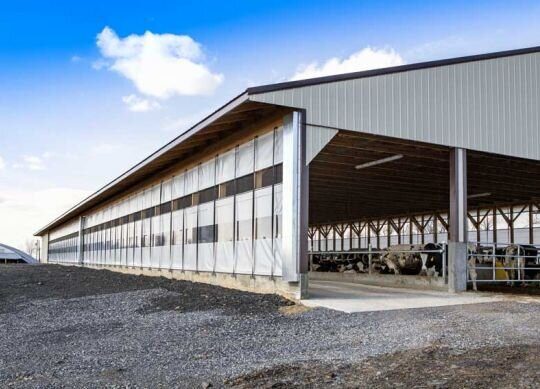Facility Focus: Back to the Curtain Management Basics
We’ve reached the time of year when weather conditions once again become cool and damp, causing dairy producers to run toward their facility’s curtains and close buildings up tight. While it might be tempting to batten down the hatches to keep cold air from coming in, lowering ventilation and reducing air exchange is one of the worst things a farmer can do for their animals.
Keeping cows and calves comfortable during the winter months can often feel like a balancing act. According to Mike Wolf, DVM and consulting veterinarian for VES-Artex, finding the right combination between keeping animals warm while also providing adequate air exchange is essential.
“Managing curtains can feel like a constant balancing act,” Wolf says. “Sometimes, the more you open a curtain up, the easier it is for natural air to come in. But it also makes it easier for Mother Nature’s natural elements like rain and snow to come in as well. On top of that, if the air isn’t coming straight into the building, it can cause circular air movement, which can lead to stale, stagnant air. So, you want to keep the curtains open just enough to let air come in at a perpendicular angle, but not open too much to where you let natural elements in.” For power ventilated and cross-vent barns, controlling the curtain inlet allows air to come in at a more perpendicular angle, which helps introduce new air into the barn more evenly.
When it comes to managing your curtains this winter, it’s important to remember the basics, according to Wolf. These include:
Regular Maintenance
For curtains to work their best during the cooler months, it’s important to make sure they are maintained during the warmer months. According to Wolf, curtains should be looked over at least twice a year to ensure tears are repaired and equipment is working. This time should also be used to clean fans and look for any air obstructions.
During the summer, don’t leave curtains rolled up at the bottom of the building’s inlet. Doing so can allow rodents to come in and chew large holes, which can lead to unwanted drafts and potential curtain failures. Take time to test your curtains out, repair holes and grease parts to ensure everything runs smoothly when cold weather hits.
Monitor Air Flow
“For every 10′ of width, sidewall curtains should be open at least 1″ to allow air to come in,” Wolf says. “So, for a 60′ wide barn, you’d need at least 6″ opening on both sides. Additionally, the ridge opening located in the center of the barn needs to be open a minimum of 2″ for every 10′ the barn is wide. For a 100′ wide barn, this would be 20″. The barn has to be able to breathe in order to make a naturally ventilated barn function in the wintertime.”
According to Wolf, keeping top-drop curtains open a few inches helps force stale, warm air up and through the roof. It’s recommended that air comes in from the sidewall at 800′ to 1,000′ per minute in cross-vent and tunnel ventilated barns so it has a chance to mix with the warmer air before coming down to the cow level.
Consider Automation
Sometimes the most basic technology can make all the difference when it comes to ventilation. Producers can spend a lot of time and effort trying to perfect curtain levels depending on different conditions and still find that they don’t get it right. Mechanical controllers can be helpful, as they automatically adjust curtains in relation to temperature. Automatic curtain openers can help decrease the chore of opening and closing curtains and help ensure cows and calves get the fresh air they need.
When it comes to providing adequate ventilation this winter, it’s important to keep the basics in mind. Maintain a consistent maintenance schedule throughout the year to help prevent problems from occurring. Take time to monitor your barn’s air flow to ensure fresh air is coming in regularly. Lastly, consider adding basic automatic technology to help take the guess work out of managing curtains.



